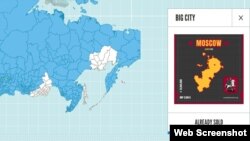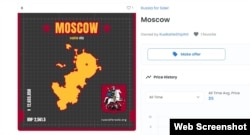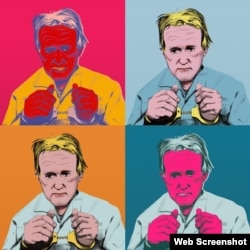TBILISI -- Nearly two months into Russia's invasion, Ukraine's allies are after some territorial spoils of their own.
Digitally, that is.
A Tbilisi-based digital creative agency is "selling Russia piece by piece" in the form of non-fungible tokens (NFTs), the unique digital collectibles built on blockchain technology, to help Ukraine "rebuild" from the 8-week-old war.
"We saw a huge potential in it -- that the majority [of people] would want to be involved in Russia's partition," Leavingstone co-founder Levan Lefsveridze told RFE/RL's Georgian Service.
It's clearly an effort to troll Russian President Vladimir Putin, whose regime punishes calls for violating Russia's territorial integrity with jail time.
But it's also part of a growing list of globe-spanning digital fund-raisers aimed at helping Ukrainian institutions, military defenders, and civilians in a conflict that has killed thousands, leveled towns, and displaced millions of Ukraine's prewar population of around 34 million people.
Putin announced the unprovoked large-scale invasion in late February, days after he suggested Ukraine had never experienced "real statehood."
In the first of three planned phases of the Russia For Sale project, Leavingstone is auctioning off 2,443 regions of Russia depicted on playing cards with name, size, and a "weirdly authentic coat of arms." Potential buyers can choose their parcel of land from an interactive map.
So if you've ever dreamed of buying up the Achkhoi-Martan administrative district or pined for the southern Perm city of Gornozavodsky, now's your chance.
So far, 23 of the regions have sold for a combined total of $18,704, denominated in the Ethereum cryptocurrency.
Leavingstone says all the proceeds will be transferred to the digital wallet of Ukraine's Ministry of Digital Transformation, which has conducted cyberwarfare, countered disinformation, and recruited a volunteer IT army against Russia since the invasion began.
The second phase of the project will comprise NFTs representing major Russian architecture, including the Kremlin and the lavish "Putin Palace" that reportedly cost upward of $1 billion to construct on the Black Sea coast.
A third phase will auction off "Lenin himself," a digital version of the "stuffed granddaddy of the red revolution."
Lefsveridze said a team of 10 to 15 people took a little over a month to realize the project.
"As an answer to Russian imperialist aggression, we decided to sell Russia's territories for good!" the project's website says. "Putin is known for grabbing other countries' lands. So, let's give him the taste of his own medicine."
Tens of millions of dollars' worth of cryptocurrency donations have already poured into Ukraine since Russia's invasion began on February 24, according to cryptoasset tracker Elliptic.
A growing number of projects have now targeted the exploding market in NFTs, the technology that has taken the worlds of art, culture, and sport by storm despite regulatory, convertibility, and environmental concerns.
The Ukrainian Ministry for Digital Transformation launched its own NFT sales drive in March under the title "Meta History Museum Of War." It is a timeline of NFT artwork depicting moments captured in tweets or other social-media posts by notable Ukrainians, institutions, or international media.
In addition to the Georgian Russia For Sale effort, the Ukrainian ministry also cooperates with NGO Noosphere's #ArtForLife project, which aims to raise $500,000 for the defense of Ukraine.
Leavingstone pledges that all of the proceeds of the Russia For Sale project will go toward supporting Ukraine.
NFTs are essentially proof of ownership of virtual assets, and their sales have skyrocketed in recent years, including $69 million for a 13-year-long digital collage by American artist and graphic designer Mike Winkelmann, better known as Beeple.
Unlike the traditional art market, one of the lures of NFTs is that artists receive royalties from any future resale of their work -- whether art patron to art patron or by an auction house.
In this case, Leavingstone says 5 percent of resale values will go to Ukraine and another 2.5 percent commission will go to New York-based NFT marketplace OpenSea.
The M81 creative studio in the western Ukrainian city of Lviv recently announced it was auctioning off an NFT depicting handcuffed Ukrainian oligarch and politician Viktor Medvedchuk in Andy Warhol-like imagery on OpenSea. Bidding started at 0.1 Ethereum, the equivalent of about $300. M81 vowed the proceeds would go to the "volunteer needs" of Ukraine.
In the early days of the invasion, a project backed by a member of the Russian punk collective Pussy Riot reportedly sold an NFT of the Ukrainian flag for nearly $7 million, after drawing thousands of bidders.
Leavingstone described Russia as "the most evil regime of our time." It referred to decades of Moscow's post-Soviet military interventions in Georgia.
"The military aggression in 1992 and 2008 significantly impacted our Georgian team members, who experienced firsthand how destructive the Russian invasion can be," the group said on the Russia For Sale site.
Russian troops backed separatists in the Abkhazia region and fed civil strife in the rest of Georgia in 1992 and then fought an intense five-day war in 2008 to prevent Tbilisi from reestablishing control over Abkhazia and another breakaway Georgian region, South Ossetia.
Russia occupied and annexed Crimea and began intensive support for armed separatists in eastern Ukraine in 2014 after public unrest unseated a pro-Moscow president and government.













